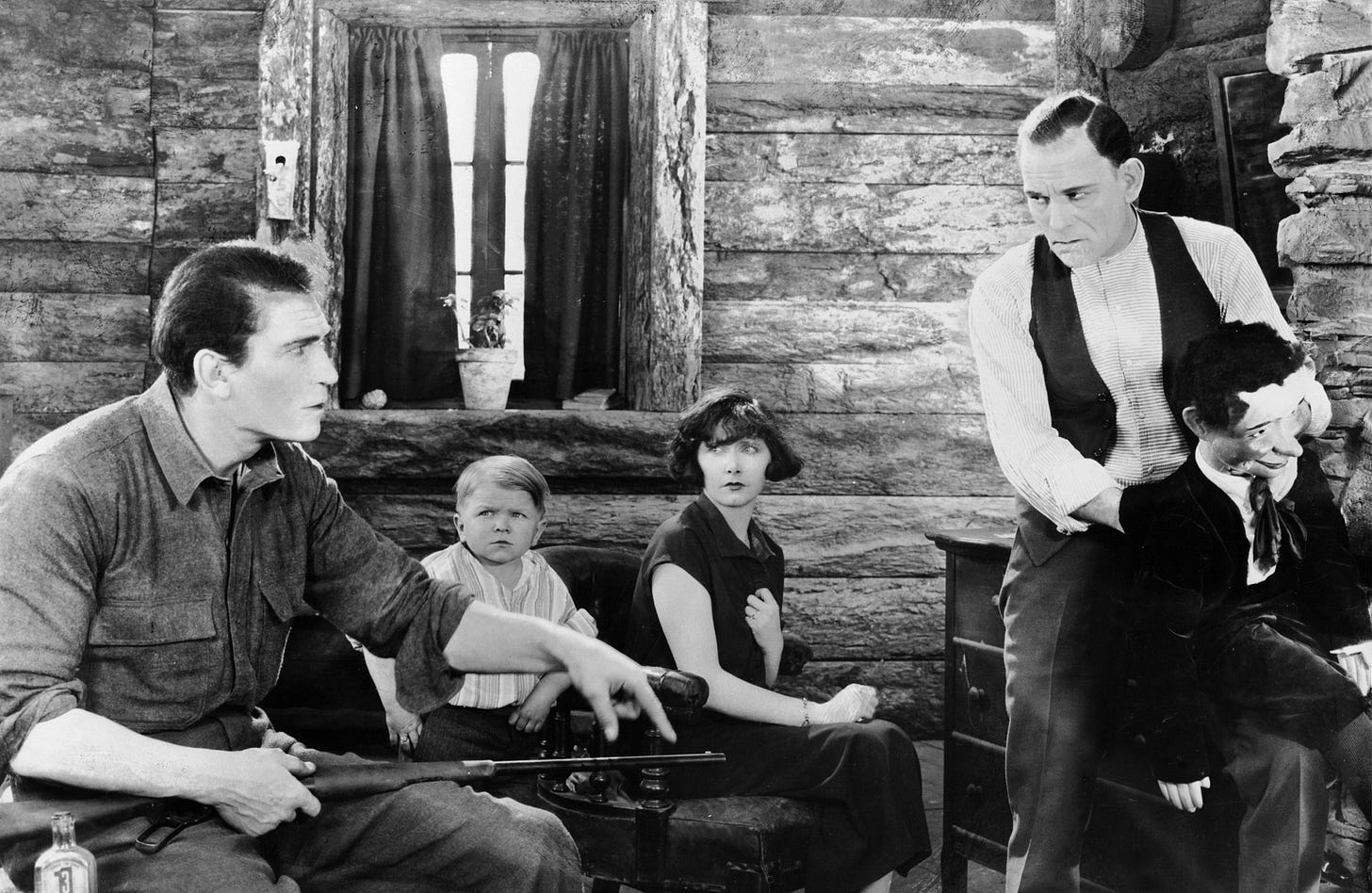This is a weird one.
Three sideshow exiles—Tweedledee, a dwarf (Harry Earles1), Hercules, a strongman (Victor McLaglen2), and Echo, a ventriloquist (Lon Chaney)—run a burglary racket out of a parrot shop. Echo is the brains of the operation. Disguised as an old woman (“Mrs. O’Grady”), he sells mute parrots to unsuspecting blue-bloods, using his ventriloquism to give the impression that the birds are particularly chatty—a talent which naturally disappears as soon as they leave the store. When the customers call to complain, “O’Grady” makes a housecall with her “grandson”—Tweedledee in disguise—who searches the residence for valuables. After they’ve confirmed that the house is a suitable target, they return at night and help themselves, aided by the strongman.
This seemingly perfect setup is complicated when Rosie (Mae Busch3), Echo’s pickpocket girlfriend who’s posing as Mrs. O’Grady’s granddaughter, begins to fall for the parrot store’s hired help, Hector McDonald (Matt Moore4), who knows nothing of the scheme. As Echo begins to lose focus and is consumed by jealousy, Hercules and the dwarf try to pull a job themselves—and badly botch it. With the law closing in, the Unholy Three frame McDonald for their crime, kidnap Rosie, and go on the run.
Echo is a very different role for Chaney. Neither grotesque nor sympathetic, he’s charming only in a thuggish sort of way, at least when he isn’t scowling or snarling at everyone. Egotistical, vengeful, menacing, and manipulative, he’s one of the best villains I’ve ever seen in a silent film—unnerving like a well-acted cinema gangster, but with a touch of humanity that makes him unpredictable. One of the movie’s great virtues is the way it builds up the tension in a scene. Director Todd Browning likes to put characters in situations where the outcome is uncertain and then slowly turn up the heat and watch them sweat. It makes sense in a film about impersonation, but it takes on a moral quality in the film’s final act, as Echo is forced to decide whether to save his rival from the electric chair. Chaney’s ability to take a cruel, self-centered character like Echo and break him down as he struggles with his conscience is really impressive. But then again, making monsters human was always his forte.
Of the supporting cast, it’s Earles who really shines. Given the ridiculous premise—an adult man having to pretend to be a baby—it’s incredible how well he makes it work. Prickly, dapper, and borderline psychopathic as a criminal, sickeningly cute (and utterly creepy) as an ersatz infant—Earles really delivers the goods, stealing the scene with the effortless way he swaps between the two personas. Harry Earles never got much respect as an actor—in most of his roles, he’s credited merely as “Midget,” if at all.5 But Tweedledee gave him a chance to take on a really interesting character—a dangerous villain—without being held back by his voice, which was high-pitched with a pronounced German lisp. His performance alone is worth giving The Unholy Three a try.
But like I said in the beginning of the review, this is a weird one. Ventriloquist dummies, giant apes, stolen jewelry, crossdressing, and true love all have a part to play in The Unholy Three, and if the movie has a message, it’s that appearances are always deceiving. A baby in a cradle can be a murderer in disguise. A kind old woman can be a criminal mastermind. The words coming out of a witness’s mouth might not be their own.
For the Man of a Thousand Faces, it’s a perfect match.
Postscript: It’s tempting to analyze this movie as a companion piece to Todd Browning’s other movie about circus freaks, but I’ve tried to avoid doing that here. Really, the similarities are superficial—both feature circuses and Harry Earles, but that’s about it. Freaks is an extraordinary assertion of human dignity in the age of racism, euthanasia, and eugenics—a prophetic cry against the idea that there is such a thing as “life unworthy of life.” The Unholy Three is a well-made genre picture with a stellar cast and an insane premise. It’s good. It’s worth watching. But Freaks changed my life, and The Unholy Three did not.
Born Kurt Schneider in Stolpen, Germany, Earles stood 3’ 3” tall and was only 22 years old in 1925. The Unholy Three was his first film role—he would go on to appear in the 1930 remake, and also played the leading part in Todd Browning’s 1932 masterpiece Freaks. His final film was The Wizard of Oz (1939), in which he re-pre-sen-ted the Lol-li-pop Guild (yeah, now it’s stuck in your head, too).
This was one of McLaglen’s first roles after moving to the United States in 1924-25, having previously starred in several British films. A WWI veteran and former heavyweight boxer, McLaglen went from playing drunkards and thugs to leading men when he scored the role of Captain Flagg in What Price Glory? (1926). He continued to act into the 1950s, playing opposite everyone from Cary Grant to Boris Karloff to John Wayne. The year after his death in 1959, he was awarded a star in the Hollywood Walk of Fame.
Busch is best remembered for her many appearances alongside Stan Laurel and Oliver Hardy, starting with the silent short Love ‘Em and Weep (1927) and continuing all the way into the mid-1930s, making her final appearance in 1936’s The Bohemian Girl.
Moore was an incredibly prolific actor, but after 1940 most of his roles were uncredited bit parts.
One IMDB entry even lists him as “Midget in Trash Basket.” Hollywood was not kind to this man.






